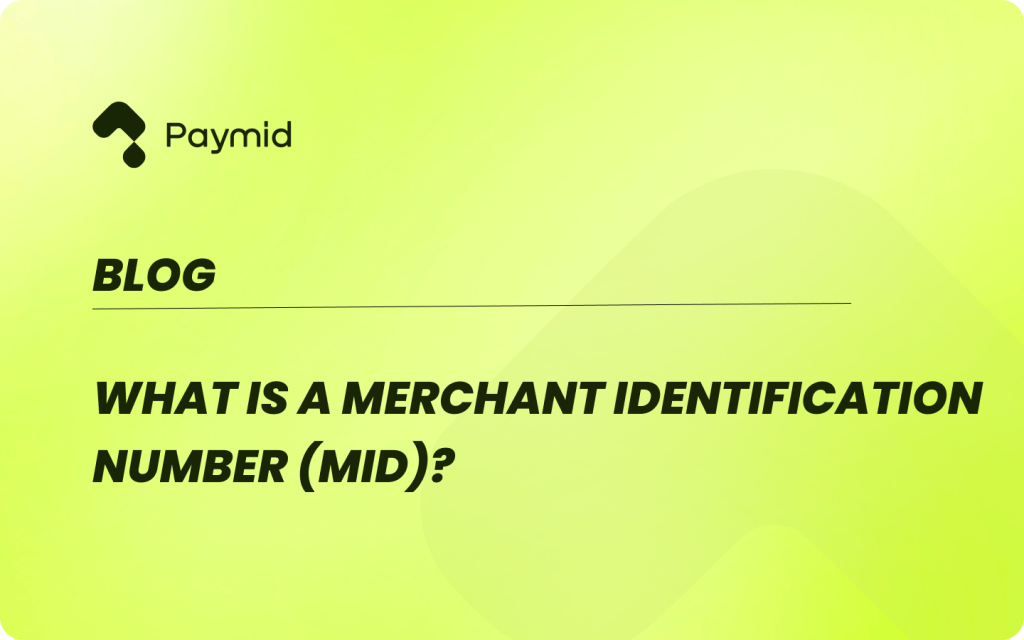What is a Merchant Identification Number (MID)?

A Merchant Identification Number (MID) is a 15-digit alphanumeric identifier used to facilitate card payments for businesses.
If you’re already accepting card payments, you should have a merchant identification number. Also known as MID, this number is a unique code linked with your business and your specific merchant account. Your MID is a significant element of being able to process secure and timely payments to your merchant account. This article explores everything you, as an online business, need to know about MID’s.
Read More:
- How To Navigate Payment Compliance Regulations in 2024
- Mastering B2B Payment Optimization [Expert Tips]
- Merchant Acquirer vs Payment Processor: A Detailed Comparison
- Payment Optimization For Business [Everything To Know]
What is a merchant identification number (MID)?
A merchant identification number is a unique, numerical code that the acquiring bank assigns to merchants once they successfully open their merchant account. The MID identifies a merchant to their acquiring bank.
How do I get a Merchant ID Number?
To accept and process card payments and eventually get a MID, you need to request for a merchant account. As part of your merchant onboarding application, your acquiring bank will most likely ask you to submit official documentation as part of the Due Diligence and Know Your Customer processes. This documentation will be revolving your company structure, legal basis, legal documents, among many other details. Once the merchant successfully undergoes the due diligence processes and the agreement is signed by both parties, the acquiring bank creates the Merchant Identification Number (MID). To generate a Merchant Identification Number (MID) that will start to route your payments, your acquiring bank will also ask you questions such as the estimated volume of purchaess, your preferred currency/currencies, if you will process one time transactions or recurring payments or if you also need to apply for fraud prevention solutions or 3D Secure etc.
Aside from routing transactions, this Merchant Identification Number (MID) is used to identify you as a merchant during the accepting of debit and credit card purchases, adjustments, chargebacks and fees, among many others. For each debit or credit card transaction, your acquiring bank will transmit the Merchant Identification Number (MID) along with the cardholder’s details to all parties (such as card schemes and issuing banks) that will potentially authorise and accept the payment. Once the transaction is approved by the issuing bank, the acquirer gets a “go ahead” to deposit the funds from the customer’s bank account to your merchant account. The time for the transmission of funds varies among merchants and heavily depends on the settlement terms with their acquiring banks which typically is a negotiation and based on industry and risks for the bank.
Why do I need a Merchant Identification Number (MID)?
Every business, regardless of online or offline, which accepts card payments, needs a Merchant Identification Number (MID) to identify their specific merchant account in a card transaction and transmit the funds to it. A Merchant Identification Number (MID) is a sensitive piece of information and should be kept private, similar to one’s banking details.
What is a TID?
TID is the Abbreviation for terminal identification number. A TID is a unique identification number linked with your Merchant Identification Number (MID) and each of your terminals that process card payments. A TID can be utilised for both card present and card not present (CNP) transactions. In a card present purchase, the TID is assigned to a POS machine (terminal), whereas in card not present transactions a TID is linked with a virtual terminal (online). A merchant with a single MID may use a number of TID’s under it.
Can a business have multiple MID’s?
Generally, a single merchant account with an assigned MID is sufficient for managing a small to medium-sized business. Note that a single MID can encompass several TIDs. The number of MIDs assigned to your business will depend on your business model and the transactions you process through your acquirer.
Can my MID be lost?
You can’t technically lose your MID. However, if you violate the said terms of service between you and the acquiring bank or payment service provider (for instance due to excessive chargebacks or other potentially fraudulent activity), it could lead to your acquirer pausing or even terminating your merchant account.
In essence, either of these situations means that you will not be able to accept card payments with your acquiring bank, which could be vital for an online merchant, as they would have no other way of revenue. The main key to protecting your merchant account and your MID is limiting chargebacks and ensuring your transactions are secure and fraud-proof. Your payment service provider (PSP) should be able to provide you with optional tools to prevent or reduce chargebacks due to criminal fraud, as well as give you transparent access to analytical data that can help you boost your performance and increase your acceptance conversions.
How can Paymid help with Merchant Identification Number (MID)?
Paymid is not an acquiring bank so we do not issue Merchant Identification Numbers (MID), however, our partners do. With Paymid we give you access to hundreds of fully integrated connections that can easily help you obtain your own MID.

